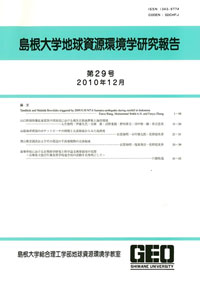島根大学総合理工学部地球資源環境学教室
ISSN:1343-9774

ダウンロード数 : ? 件
この文献の参照には次のURLをご利用ください : https://ir.lib.shimane-u.ac.jp/6439
島根大学地球資源環境学研究報告 25
2006-12-27 発行
Major and trace element analyses of Tertiary sedimentary rocks from the Sylhet basin, Bangladesh
Hossain H.M.Zakir
Roser BarryPaul
ファイル
内容記述(抄録等)
Whole-rock major and trace element X-ray fluorescence analyses are reported for 238 samples (115 sandstones, 123 mudrocks) from the Jaintia, Barail, Surma, Tipam, and Dupitila Groups of the Sylhet basin, Bangladesh, as part of a study of their provenance. The units examined range from Late Eocene to Plio-Pleistocene in age. The samples analyzed were taken from core material from four hydrocarbon exploration wells, and also from surface outcrop. Loss on ignition contents are generally low (< 6%), although occasional higher values occur. SiO_2 contents of the sandstones are usually greater than in the mudrocks, but formation averages of both lithotypes exceed that of average upper continental crust (UCC). Average abundances of Pb, Zr, Th, Ce and most ferromagnesian elements (Sc, Fe_2O_3, TiO_2, Ni, Cr, V) are also usually greater than in UCC. In contrast, average contents of CaO, Na_2O, and Sr are strongly depleted relative to UCC ; Nb, K_2O, Rb, MgO, Al_2O_3, and Ba show lesser and more variable depletion.
Other Article
PP. 49 - 59
